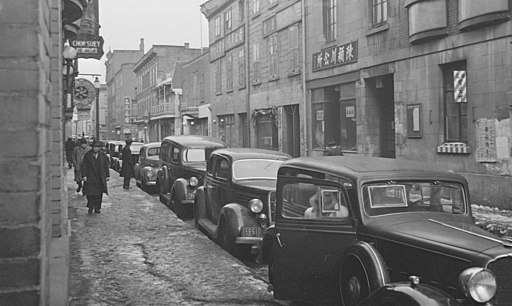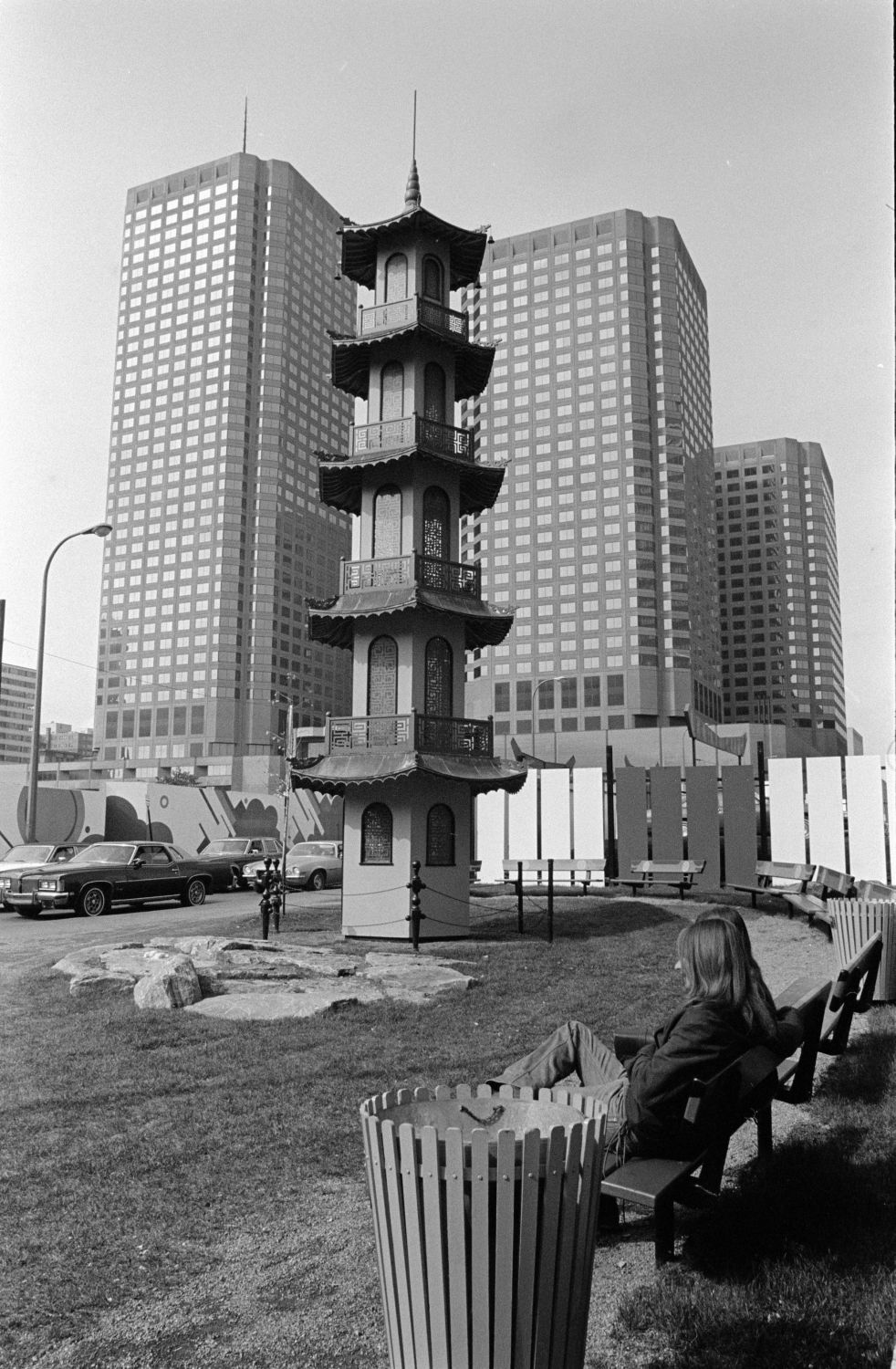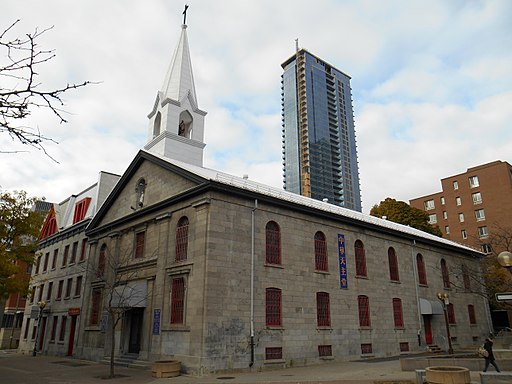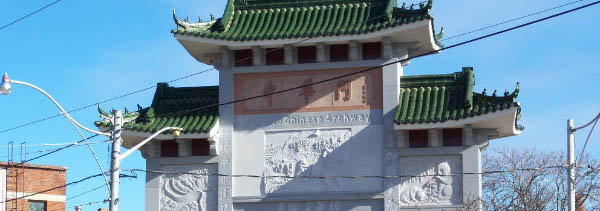Established by Chinese immigrants from Western Canada at the end of the 19th century, this neighbourhood in the Montreal borough of Ville-Marie is one of the oldest Asian communities in North America. Unofficially recognized in 1902, it became a true tourist attraction immediately following Expo 67.
The neighbourhood is located between Viger Avenue, Saint-Urbain Street, and René-Lévesque and Saint-Laurent Boulevards; its main artery is De La Gauchetière Street. It contains a multitude of businesses founded by members of the Chinese-Canadian community and immigrants from Southeast Asia. Montreal’s Chinatown is marked by both its architecture and its cultural traditions.
History
The first Chinese immigrants to settle in Montreal were mainly from southern China (see Immigration). They arrived through California and then British Columbia, where, drawn by the gold rush, they started working in the mines of the Fraser River Valley (see Fraser River Gold Rush). From 1880 to 1885, under particularly difficult conditions, 15,000 Cantonese workers also participated in building the Canadian Pacific Railway (CP). Victims of racism, several thousand of them headed for Eastern Canada (see Prejudice and Discrimination).
Newcomers established themselves on De La Gauchetière Street between Chenneville and Saint-Charles-Boromée (now Clark) Streets. There, they opened up small restaurants and export businesses, as well as laundromats such as Troy Steam Laundry and Montreal Steam Laundry. Some tried to settle in other neighbourhoods, but with little success.
Costly Fees
In Montreal, licenses for operating laundromats were among the most expensive, at $50 per year, which represented four months’ worth of work for these newcomers. Unsurprisingly, many were unable to pay it. In 1896, the city decided to fine uncooperative businesses: 106 were fined that year, followed by 150 in 1897, and another hundred in 1899. In 1900, after 71 Chinese laundry workers were tried, 10 of them were imprisoned for non-payment. In a written petition to the city, laundry workers asked that their establishments be tax-exempt and insisted that the fee was specifically designed to drive them out of the city. The attempt was unsuccessful and, in October 1900, 146 of them were fined.
Development and Diversification
In 1888, the Chinese community consisted of only about 30 people, but by the turn of the century, almost one thousand Cantonese immigrants had moved into the neighbourhood. The expression quartier chinois (Chinatown) first appeared in La Presse in 1902. At that time, it referred to the stretch of De La Gauchetière Street between Chenneville and Saint-Charles-Borromée (Clark) Streets. In 1911, the population had grown to more than 1,300 and, by 1915, the neighbourhood was home to almost 50 businesses and restaurants. These establishments advertised with signs bearing typically Chinese colours and characters, marking the visual and cultural appropriation of the neighbourhood.

With the start of the Cold War, Asian immigration to Canada and to Montreal increased. Many came to Canada as students, professionals or refugees from Southeast Asia — particularly from Laos, Cambodia and Vietnam. Between 1979 and 1982, Canada accepted 73,000 refugees from former Indochina. Of these, 58,000 were Vietnamese, 7,000 were Cambodian, and 8,000 were Laotian. Among the new arrivals, 16,000 gravitated towards Québec, and the vast majority reached Montreal after initially settling in rural areas. Consequently, Montreal’s Chinatown was heavily influenced by Vietnamese culture. Although the Chinese continued their commercial activities in the area, residents began to migrate towards Montreal’s suburbs. They continued to work in Chinatown, but they lived there less and less.
Revitalization and Tourism
Expo 67 breathed new life into Chinatown. The neighbourhood had been experiencing difficulties for several years, particularly because some speculators had bought up old buildings on large lots in order to demolish them and create large parking lots. These vacant lots were a scar on the neighbourhood’s image. In anticipation of the hundreds of thousands of tourists who would visit the city in the summer of 1967, Montreal authorities decided to revitalize the neighbourhood. Large metal billboards bearing Chinese characters appeared, along with Pagoda Park, which was created both to symbolize peace and harmony between peoples and to identify the Chinese community.
In the 1970s and 1980s, the neighbourhood became smaller due to the construction of several new buildings, such as the Complexe Guy-Favreau, the Palais des congrès de Montréal (Montreal Convention Centre), and the Complexe Desjardins. The construction resulted in many residential buildings being demolished and many residents leaving the neighbourhood. Nevertheless, l’Église de la mission catholique chinoise du Saint-esprit, the only church in the area, was saved from demolition when the Québec government designated it a historic monument in 1977. The church was restored in 1988, but Pagoda Park was destroyed.
In 1981, the City of Montreal wanted to renew and beautify the neighbourhood. De La Gauchetière became a pedestrian street in order to attract tourists to its businesses, and the area was more clearly identified, with signs, Chinese paintings, and street lamps.
In the late 1980s, with the liberalization of the Chinese economy and Hong Kong’s return to China, 166,487 people (mainly professionals and business people) chose to immigrate to Canada. These well-off immigrants invested capital in Canada and especially in Chinatown’s development, eager to make it a hotspot for the hundreds of thousands of tourists visiting Montreal each year. In order to clearly identify the neighbourhood, Pierre Bourque’s administration, with the help of the City of Shanghai, erect two enormous bright red arches spanning Saint-Laurent Boulevard. The previous two arches, built in the 1980s and located in the heart of De La Gauchetière Street, were moved to the end of that street (towards St. Dominique and Jeanne-Mance Streets), defining the borders of the neighbourhood. A new red and gold pagoda temple was also built at Dr. Sun Yat-Sen Park.

Despite these various projects, the infrastructure of the neighbourhood was suffering by the early 2010s. In 2014–15, in order to reinvigorate the neighbourhood, renew its image and showcase its touristic value, the borough of Ville-Marie launched a first revitalization phase by revamping Dr. Sun Yat-Sen Park as well as the commercial and pedestrian street of De La Gauchetière West, between Clark and Jeanne-Mance Streets. A new mural, visible from René-Lévesque Boulevard, was also inaugurated by Mayor Denis Coderre in the summer of 2015.
In recent years, historical preservationists and the Chinese community raised concerns regarding Chinatown’s historical value in the face of real estate developments. In July 2023, the Quebec government granted heritage status to parts of Montreal’s Chinatown.
Cultural and Community Life
The neighbourhood features numerous specialty grocery stores and restaurants, and is overflowing with hundreds of businesses, where visitors will find typical Chinese valuables, as well as Asian medicine shops. Because of its proximity to various hotels, conference centres, and office buildings, the restaurants attract both conference-goers and public servants.
Although Chinatown is more commercial than residential, its community life is vibrant and significant. The area is home to Montreal’s largest Chinese school (with about 1,500 students), a bookstore, a hospital (inaugurated in 1999), and a community centre offering rich cultural and social programming. Ceremonies, exhibits, festivals and even a carnival are all part of the community calendar. Despite the proliferation of Asian restaurants in the city and the creation of a second Chinatown in Brossard (12 per cent of whose population is of Chinese descent), Montreal’s Chinatown remains the nerve centre of Chinese New Year celebrations.
See also Dr. Sun Yat-Sen Classical Chinese Garden.

 Share on Facebook
Share on Facebook Share on X
Share on X Share by Email
Share by Email Share on Google Classroom
Share on Google Classroom







